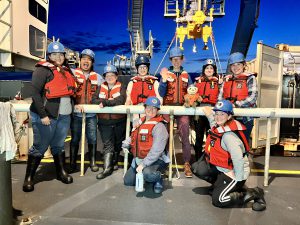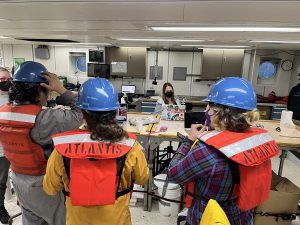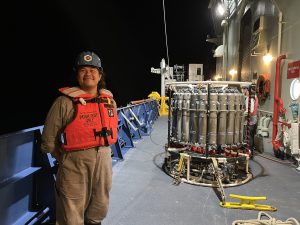Stacey Sebert, New York State Master Teacher and grade seven and eight science teacher at Sand Creek Middle School, was recently an On-Board Educator with Rutgers University’s scientific research project PUFINS at Sea. PUFINS stands for Paleo Unsaturated-alkenone Fluxes In Northwest Sediments.

The goal of the project was to recover cores from the Holocene period (the last ~12,000 years) to reconstruct sea-surface temperatures in the North Atlantic Ocean by examining the changes in alkenones recorded in the fossils found in the sediments. This data would allow researchers to address questions about the “Holocene Conundrum”, an issue hotly debated in the climate community, where cooling trends are observed in the North Atlantic during an otherwise warming world. During the 14 day voyage, Sebert got to be a part of the science crew. She learned how sonar data showed where mud could be found deep in the ocean. Sebert learned how to use equipment such as piston and gravity cores (to collect several meters of sediment), multicores (to collect the sediment and water layers at the top of the ocean floor), CTD’s (to collect water samples at different ocean depths), and McLane pumps (that filter water to collect tiny particles in the water).
Along with working with the scientists to collect samples, Sebert‘s main role was to show students from across the country what was happening onboard in real time. She spent several hours a day showing classrooms the inner workings of the ship, discussed the science conducted onboard and answered any questions the students had. Sebert and the three other educators onboard blogged and documented the entire experience of being onboard a research vessel. Their blog posts along with several lessons based on this expedition are available on the Rutgers PUFINS at Sea website. Students sent decorated styrofoam to be sent to the bottom of the ocean. Classes were excited to see how much their styrofoam shrunk, putting their newly returned from the bottom of the ocean samples on display in their schools.

“This was an amazing, once-in-a-lifetime experience that I am fortunate to have been a part of. We had a lot of work to do in a short amount of time and working with a team of like-minded individuals with a common goal was inspiring! Having first hand experience on a research vessel and being able to bring that experience to classrooms across the country has been incredible. I am looking forward to what will be uncovered as scientists analyze the samples we collected.”
The samples collected will be analyzed by several universities that collaborated on this project over the next couple years and some samples will also be archived for scientists to look at in the future.

